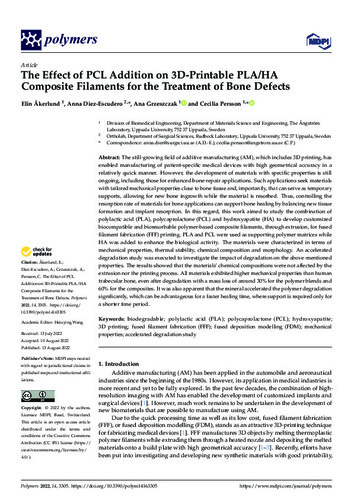The effect of PCL addition on 3D-printable PLA/HA composite filaments for the treatment of bone defects.

Cita com:
hdl:2117/382431
Tipus de documentArticle
Data publicació2022-08-13
EditorMultidisciplinary Digital Publishing Institute (MDPI)
Condicions d'accésAccés obert
Llevat que s'hi indiqui el contrari, els
continguts d'aquesta obra estan subjectes a la llicència de Creative Commons
:
Reconeixement 4.0 Internacional
Abstract
The still-growing field of additive manufacturing (AM), which includes 3D printing, has enabled manufacturing of patient-specific medical devices with high geometrical accuracy in a relatively quick manner. However, the development of materials with specific properties is still ongoing, including those for enhanced bone-repair applications. Such applications seek materials with tailored mechanical properties close to bone tissue and, importantly, that can serve as temporary supports, allowing for new bone ingrowth while the material is resorbed. Thus, controlling the resorption rate of materials for bone applications can support bone healing by balancing new tissue formation and implant resorption. In this regard, this work aimed to study the combination of polylactic acid (PLA), polycaprolactone (PCL) and hydroxyapatite (HA) to develop customized biocompatible and bioresorbable polymer-based composite filaments, through extrusion, for fused filament fabrication (FFF) printing. PLA and PCL were used as supporting polymer matrices while HA was added to enhance the biological activity. The materials were characterized in terms of mechanical properties, thermal stability, chemical composition and morphology. An accelerated degradation study was executed to investigate the impact of degradation on the above-mentioned properties. The results showed that the materials’ chemical compositions were not affected by the extrusion nor the printing process. All materials exhibited higher mechanical properties than human trabecular bone, even after degradation with a mass loss of around 30% for the polymer blends and 60% for the composites. It was also apparent that the mineral accelerated the polymer degradation significantly, which can be advantageous for a faster healing time, where support is required only for a shorter time period.
CitacióAkerlund, E. [et al.]. The effect of PCL addition on 3D-printable PLA/HA composite filaments for the treatment of bone defects. "Polymers", 13 Agost 2022, vol. 14, núm. 16, article 3305, p. 1-17.
ISSN2073-4360
Versió de l'editorhttps://www.mdpi.com/2073-4360/14/16/3305
Col·leccions
| Fitxers | Descripció | Mida | Format | Visualitza |
|---|---|---|---|---|
| 2022_The Effect ... atment of Bone Defects.pdf | 3,557Mb | Visualitza/Obre |


